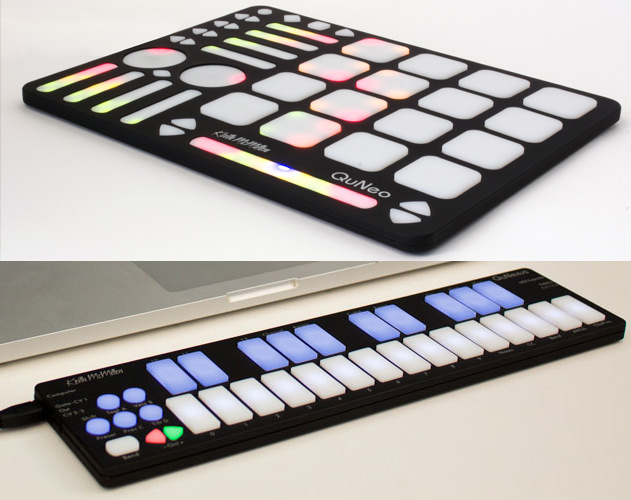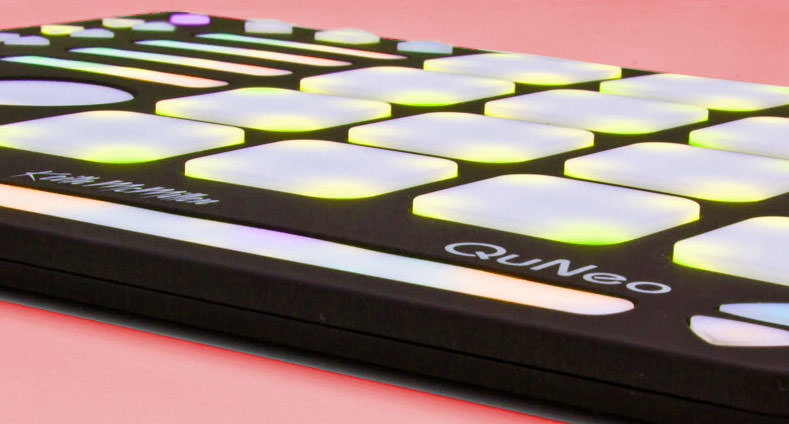Keith McMillen Instruments’ unique MIDI controllers conceal incredibly deep features and unparalleled customisability.

With the MIDI controller market so saturated, it takes a lot to stand out. That’s not to suggest that there’s anything wrong more traditional offerings – most of us still need standard keyboards, faders and pad controllers from time to time – but with so many great options already on the market, it takes a lot to offer something truly unique. Keith McMillen Instruments specialises in exactly that.
McMillen’s approach to innovative design is simple but forward-thinking: “If you make something that allows expression in a natural way, an exciting way, provides feedback to the artist and gives an advantage, people will come to love these instruments,” he said in a recent interview with Forbes magazine.
The KMI products on test here began with a Kickstarter project. Seeking $15k of investment to fund QuNeo production, McMillen received pledges totalling just under $166k (the QuNexus also flew past its funding target). With the QuNeo and QuNexus, McMillen offers a truly unique take on traditional controllers. Let’s take a closer look.
Head Of The Qu
The first impression upon removing the QuNeo and QuNexus from their packaging is that these are very well built controllers. The finish is high quality and every aspect of the units is well finished. The neat design and the slightly rubberised matt black plastic enclosures feel a little like someone crossed a Teenage Engineering OP-1 with an Ableton Push.
The QuNeo has been on the market the longer of the two units. It’s iPad-sized and features a 4×4 grid of pads plus a range of more unusual pads and sensors: horizontal and vertical ribbon controls, two circular touchpads which act a little like rotary controls, and a scattering of additional buttons and touch sensors.
The QuNexus is superficially a slightly more traditional design, essentially a two-octave keyboard with a few function buttons on the far left hand side. Instead of keys it features rubber pads much like those on the QuNeo’s 4×4 grid.
QuNeo
All of the QuNeo’s controls respond to pressure. The vast majority also respond to position, and this is where the QuNeo really sets itself apart from standard controllers. Take, for instance, the 4×4 grid of pads. Each of those pads is effectively also an XY pad and can be mapped to parameters. KMI call this three-dimensional control. When you consider just how many parameters can be controlled simultaneously, the expressive capabilities of the QuNeo are incredibly powerful.
Unsurprisingly, the QuNeo (and the QuNexus, as we’ll see) take a lot more mapping than your average controller. That’s not a criticism so much as an unavoidable side-effect of being such flexible devices. If you want to get the most out of these controllers you need to get acquainted with their software editors and dig deep into the available options, which range from standard note mapping through to LED behaviour, velocity and pressure response. The QuNeo is supplied with templates for software including Ableton, Logic, Traktor, Serato and Reason; additional templates can be installed using the Templates Installer application (you can, of course, also save presets and share them with other QuNeo users). The blue Mode button in the top left corner of the unit also allows you to swap between pre-loaded templates on the fly, using the QuNeo for multiple tasks without having to switch presets in the editor application.
It does take a little time to get used to the feel of some of the controls. More accurately, it’s the lack of feel from the recessed ribbons and circular pads which sets the QuNeo’s controls apart from a typical rotary or fader controller. There’s virtually no tactile response here, unless you count the pressure on your finger tips. But the lack of physical feedback places the emphasis back where it should be: on listening to the results of your inputs and deciding how much to turn a knob or push a fader based on how it sounds rather than how it looks or feels.
Obviously it’s not possible to move the controls on the QuNeo, but the touch-sensitive response and the level of customisation remind me of Liine’s Lemur app or TouchOSC for the iPad. This is an astonishingly multi-faceted controller which can turn its hand to just about anything. Ultimately, the value of the QuNeo depends to a large extent on how willing you are to get your hands dirty with the editor. If all you plan to do is plug it in and use it as a pad controller, there are cheaper options. But the QuNeo’s versatility is a major selling point for anyone who wants a controller which can be tailored to meet their exact needs.
QuNexus
The keyboard-style QuNexus appears relatively simple at first glance. You’d be forgiven for placing it alongside basic portable controller like the Korg NanoKey and Akai LPK25 based on looks alone, but you’d be wrong to do so. The hidden features of the QuNeo should give a clue that the QuNexus follows in a similar vein. Each of the ‘keys’ on the keyboard is a rectangular pad similar to those on the QuNeo’s 4×4 grid. That means each one responds to pressure and ’tilt’ (think rocking your finger backward and forward on the key), which can be sent on a global or per-key basis.
Much of the QuNexus’s functionality is shared with the QuNeo: the unit can be customised to respond to touch in virtually unlimited ways, made even more versatile thanks to the inclusion of two 3.5mm sockets which send analogue gate and CV signals (with adjustable scaling and calibration in the software editor) and can even act as a MIDI to CV converter (and vice versa using the expression pedal input). It’s an incredibly expressive setup, especially when connected to analogue gear or modular synths with CV inputs for parameters like filter control. Like the QuNexus, the QuNeo can also send MIDI signals over a standard 5-pin DIN connection using an optional breakout box (£42).
Conclusion
The QuNeo and QuNexus set incredible standards of customisability for controllers. The QuNeo probably has the edge when it comes to ultimate flexibility, working as everything from a chromatic pad to an Ableton clip launcher to a step sequencer controller, but the QuNexus’s reinterpretation of what a keyboard can do brings to mind some of the most expressive synths ever made, such as the Yamaha CS-80. It’s excellent for hardware synths and modular gear, but it’s perhaps even better for more advanced soft synths which can really be opened up with the QuNexus’s exceptional hands-on control of deep parameters.
We don’t have anywhere near enough space here to go into detail about all of the possible applications for these innovative and versatile devices. Instead, let’s sum it up like this: if you can imagine a performance feature you’d like to find in a miniature keyboard or control surface, you can probably create a QuNexus or QuNeo template which allows it.
The Verdict
Price: $249 & $149
The Final Word
Two of the most versatile MIDI controllers we've ever come across.

10.24 PM
Minor QuNexus detail: the keys reports pressure and tilt. So its a 2D controller, not a 3D (pressure, x, y) controller like QuNeo.
10.40 PM
Thanks dslsynth. We’ve amended the text to clarify that point.